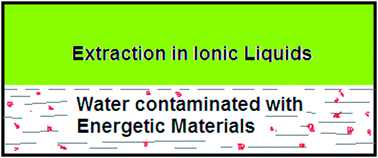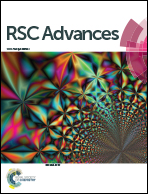Treatment of energetic material contaminated wastewater using ionic liquids†
Abstract
The contamination of energetic materials (EMs) in wastewater during its production and application is one of the serious environmental issues. Selected hydrophobic ionic liquids (ILs) were developed, characterized and applied for the separation of EMs such as TNT, tetryl and picric acid from aqueous medium. Batch-wise extraction experiments were performed at 700 rpm in a capped glass vial at 25 °C. The IL containing anion, bis(trifluoromethanesulfonyl)imide ([NTf2]−) played a vital role in the separation of EMs due to its large ionic radius. It was, therefore, extensively used for the optimization of various process parameters. The investigation of the extraction mechanism has revealed that a C–H⋯Π interaction is present between the IL and EM. The results show the highest distribution ratio of 2095 for the tetryl amongst the other EMs used. A maximum separation factor for tetryl/TNT, TNT/picric acid and picric acid/tetryl was observed to be 1.75, 6.65 and 0.15, respectively for the IL, 1-octyl-3-methylimidazolium bis[trifluoromethanesulfonyl] imide ([OMIM][NTf2]). After the extraction, the IL was separated from the aqueous phase and repeatedly treated five times with a fresh batch of EM.


 Please wait while we load your content...
Please wait while we load your content...